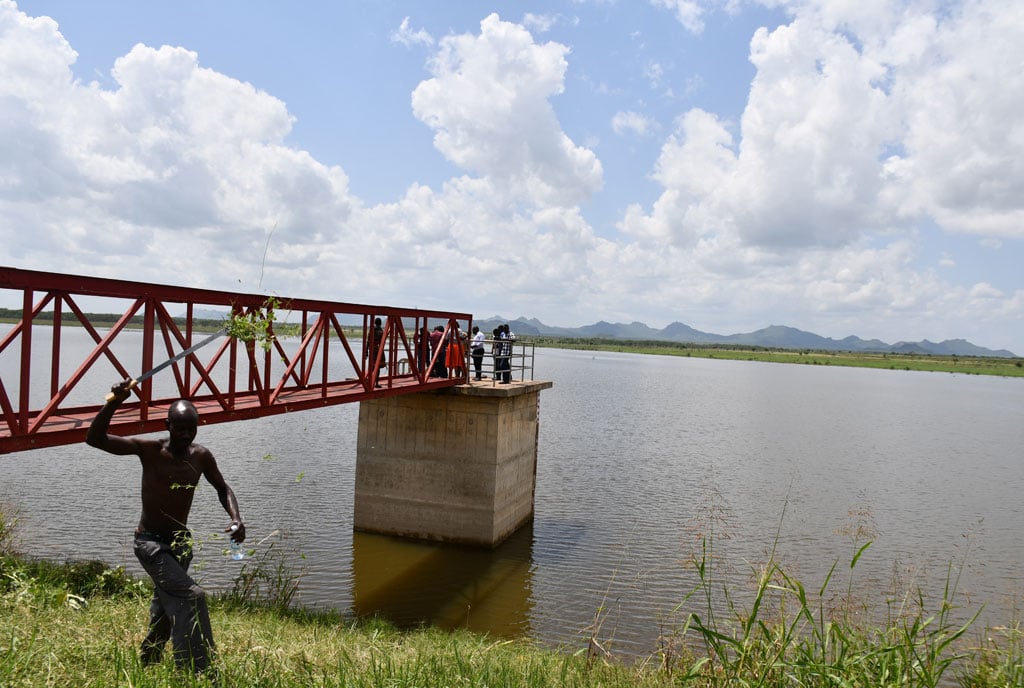Prime
Leaders propose Shs200 fee for herdsmen to access dams in Karamoja

A man slashes near Kobebe Dam in Moroto District on June 1, 2024. The dam developed some technical issues due to vandalism. PHOTO/FRED WAMBEDE
What you need to know:
- Other dams like Longoromit and Kaomeri also had major cracks, are silted or have dried up.
As part of efforts to avoid vandalism of dams, which were constructed by the government to provide water for livestock and crop production in the Karamoja Sub-region, leaders have proposed to effect a fee on every cow.
Some of the dams constructed around 2011 are now under rehabilitation by the Ministry of Water and Environment after they dried up due to a long dry spell and others developed technical failures due to vandalism by the pastoralists.
At the weekend, sources said cracks have developed on Kobebe Dam in Moroto District. Apart from cracks, some of gabion mattresses have also been damaged, among other defects.
Kobebe, with a capacity of about 2.2 million cubic metres of water is one of the dams currently under rehabilitation. Others include the Longoromit Dam in the Kaabong District, which has a holding capacity of 1.42.2 million cubic meters of water.
Mr John Akiiki Adupe, the chairperson of Lotisan Sub-county, said Kobebe Dam, the biggest in the sub-region faced a lot of pressure from enormous numbers of cows from the Karimojong and Turkana
“After this rehabilitation by the government, we should impose a fee so that the money is used for maintenance because lack of maintenance was also a challenge,” Mr Adupe said.
Kobebe Dam has eight troughs, with six earmarked for cattle and other two for sheep and goats.
But locals said the pastoralists would lead their animals into the dam thus vandalising it, instead of the animals using the troughs.
Other dams like Longoromit and Kaomeri also had major cracks, are silted or have dried up.
Dr Francis Olaki, the district production and marketing officer of Moroto District, said there is need to restrict access to the dam to mitigate vandalism.
Mr David Koryanga, the chairperson of Moroto District, urged the ministry officials undertaking the rehabilitation to do good work.
“This dam is dear to us and we need it to function to support our people to access water for the animals,” he said.
Dr Fredrick Eladu, the Kaabong District production officer, said before Longoromit dam dried up, it supported the multiplication of more than 5,000 fish, contributing to the local economy and nutrition.
“I now warn the community members against cultivating around the catchment area to prevent future silting,” he said.
The dam, which is one of the flagship projects of the government in the sub-region used to serve about 6 million animals daily.
Mr Patrick Okotel, the manager of Water for production eastern region, said the ministry is fixing issues at the dam.
“These dams take care of cows from different districts but the biggest problem is the Turkanas from Kenya. They come with cows in big numbers, thousands and in our design, we had not provided for the Turkanas whose influx is enormous,” he said.
Mr Okotel said the rehabilitation of the dams will include working on embankments, water supply lines, and livestock troughs.
He added that they have engaged leaders on levying a fee of Shs200 per cow to help in maintenance of the dams. “There should be a minimal cost to be paid so that people own the facility,” he said.




